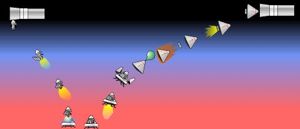
Home - Search - Browse - Alphabetic Index: 0- 1- 2- 3- 4- 5- 6- 7- 8- 9
A- B- C- D- E- F- G- H- I- J- K- L- M- N- O- P- Q- R- S- T- U- V- W- X- Y- Z
MEM

MEM
Credit: © Mark Wade
AKA: Mars Excursion Module. Status: Study 1967. Gross mass: 49,400 kg (108,900 lb). Height: 9.00 m (29.50 ft). Diameter: 9.00 m (29.50 ft).
This lander design was the first to incorporate the Mariner 4 findings on the tenuous nature of the Martian atmosphere.
The lander followed the aerodynamic form of the Apollo Command Module, a configuration that was completely understood. The crew would endure 7 G's on Mars atmospheric entry. The heat shield was designed to allow re-entry into both the earth and Martian atmospheres so that it could be thoroughly tested from earth orbit prior to any Mars mission. After slowing to near-supersonic speed, the capsule would be stabilized by a drag chute, then a ballute. At 3 km over the surface, the ballute would be jettisoned and the main engine, using liquid oxygen/liquid methane propellants, would fire to bring the capsule to a soft landing on the surface. Enough propellant was available for a two minute hover. Six landing legs could handle slopes of up to 15 degrees.
The design was modular, so that by deleting ascent propellant and internal compartments and surface supplies, total lander mass could be between 30.0 and 49.4 metric tons. The lighter stripped lander, departing from and returning to a low-earth orbit Mars orbiter, could support only two crew for four days on the surface. The heavier all-up version could support four crew for thirty days and had enough delta-V to reach an orbiter in a higher Mars elliptical orbit. Variations of internal equipment fit and propellant between these extremes could accommodate a variety of missions.
After exploring the Martian surface and taking samples, a separable ascent stage would bring the crew and their samples back to the mother ship in Mars orbit. Up to eight strap-on propellant tanks fuelled the same engine during ascent and were jettisoned as the propellant was depleted. The propellant remaining in the core was used to achieve orbit and dock with the waiting mother ship in Mars orbit.
North American estimated that development would have to start in 1971 in order to support a 1982 landing on Mars. Before the main landing mission, flight tests would take place in earth orbit, using six test articles. Three two-stage Saturn V vehicles and three Saturn I boosters would put the test articles on suborbital and orbital trajectories. In the final 1979 test a MEM and manned Apollo CSM would be placed in earth orbit. The Apollo CSM would separate, transpose, and dock with the MEM. The crew would enter the MEM and ride it to a landing on the earth's surface.
Development Cost $: 4,100.000 million. Cost Notes: 1967 dollars.. Crew Size: 4. Habitable Volume: 4.00 m3.
Family: Mars lander. Country: USA. Spacecraft: IMIS 1968, Von Braun Mars Expedition - 1969. Propellants: Lox/LCH4. Agency: North American. Bibliography: 253.
 | MEM Credit: © Mark Wade |
Back to top of page
Home - Search - Browse - Alphabetic Index: 0- 1- 2- 3- 4- 5- 6- 7- 8- 9
A- B- C- D- E- F- G- H- I- J- K- L- M- N- O- P- Q- R- S- T- U- V- W- X- Y- Z
© 1997-2019 Mark Wade - Contact
© / Conditions for Use
